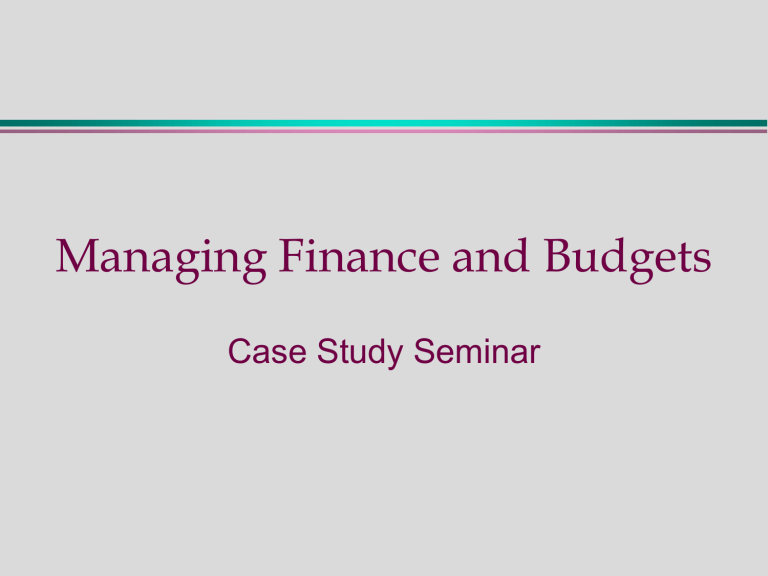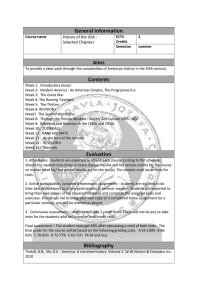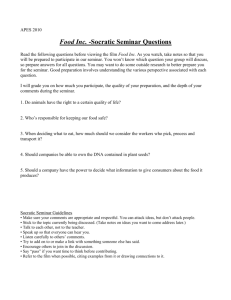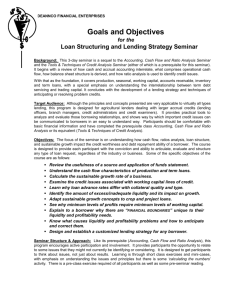Case Study

Managing Finance and Budgets
Case Study Seminar
Revision Seminar
•
•
•
•
• Assessment Arrangements
Learning Outcomes of the Module
Sample Case Study Materials
Keytronics PLC Background
Approaches to the Case Study
Assessment Arrangements
There are two different elements:
•
•
Multiple Choice Questions (50%)
This will take place in the normal lecture times
Monday December 2nd 1.00pm
Thursday December 5 th 9.00am
Case Study (50%)
•
•
This will take place in one of the four seminar times:
Thursday December 5 th 12.00noon or 1.00pm
Monday December 9 th 9.00am or 10.00am
Assessment Arrangements
Multiple Choice Questions (50%)
Sample Questions have been available via the MCC for the last 10 weeks. The assessment is based on material from lectures 1-10. You are urged to view the questions and to check your answers via the submit button. The questions in the MCQ test will be similar to these.
Case Study (50%)
The Data has been available for the last two weeks. The assessment is based on material from lectures 1-6, and some related material from lecture 8. You have been provided with sample case studies A, B and C.
Summary of Learning Outcomes:
Knowledge and Understanding
•
•
•
•
•
•
•
•
•
You will need to ensure that you understand the terms and definitions of:
Balance Sheets,
Profit and Loss Accounts,
Cash Flow Statements,
Ratio Analysis,
Sources of Finance,
Costing
Pricing
Budgeting
Management of Working Capital
Summary of Learning Outcomes:
Skills
You will need to ensure that you can:
• Interpret the items on the a Balance Sheet, a Profit and Loss
Account, and a Cash Flow Statement and work out how a particular transaction will alter these.
• Calculate a range of financial ratios from the above three statements and interpret their meaning, in particular to analyse the management of working capital and make suggestions as to how this might be improved
• Apply the principles of costing to determine a break-even point, undertake a full costing and work through some of the details of
Activity-Based Costing
• Determine the most appropriate pricing strategy to apply in a particular situation.
• Determine the financial benefits of a particular capital investment project or a particular source of finance
Revision Seminar - Case Study A
John Richards and Sons Ltd is a well-established family business. The managers are considering expansion of their operations but they estimate that £2 million of additional capital will be needed to finance their plans.
The latest balance sheet for the business is shown on the following page.
1.
2.
Summarise the Balance Sheet with headings, subheadings totals and subtotals.
Discuss the company’s capital structure, using ratios where appropriate and evaluate alternative sources of finance open to the company.
Case Study - Balance Sheet Entries
Land & Buildings
Plant & Equipment
Stock
Debtors
Cash
Trade creditors
Long Term Loans - 12% repayable in 10 years time
Ordinary Shares of £1 each
Retained profits
8% Preference Shares
£ 000
1600
2600
2000
1600
200
(1000)
(2600)
2000
1200
1200
Further Activity ( from Lecture 8 )
A Company is looking to raise additional funds to finance expansion into a new market. It believes it will need an additional £50,000 to use as working capital, £250,000 for purchase of equipment, and £75,000 to spend on marketing activities.
Which possible sources of finance should the Company investigate to finance each area of the project and what are the various issues it needs to consider before deciding on the way forward?
Activity -Solution
An additional £50,000 to use as working capital:
This might possibly be achieved through efficiency gains (lowering current stock levels, tighter debt control, extension of credit – or possibly debt factoring). If not, this would need to be included in the equipment purchase.
£250,000 for purchase of equipment.
This will need to be funded either through additional share capital (New share issue - look for Venture Capital), or if this is not possible, other long-term financing, such as a long-term loan, or debentures. Explore whether a
Government grant is available.
£75,000 to spend on marketing activities.
This is revenue expenditure, and will therefore be accounted against profits in the year in which it occurs. If retained profit levels are high, the company could consider taking reduced profits or even a loss in the next financial year, although this would not go down well with the new shareholders! Alternatively, the company could consider an overdraft.
Activity - Issues
The main factors to be taken into account are:
•
Risk:
If the company borrows, there is a risk that there may not be sufficient funds at the maturity date to cover the repayment, and will not be able to find a replacement loan.
Matching:
• The company may wish to match the life of the long-term asset with the maturity date of the loan.
•
Cost:
Interest rates for long-term loans are generally higher than those for shortterm loans.
•
Flexibility:
• Short term loans may be more flexible and responsive.
Financial Gearing:
What is the current gearing ratio and how will the proposed funding alter this?
What would the effects be if the sales were less than expected?
Revision Seminar - Case Study B
Carpetright Ltd is a retailer which operates a network of stores throughout the UK. The company aims to achieve a 30% share of the market over the next few years.
Using the data provided, comment on the financial performance and position of the company from the point of view of:
1.
2.
A private shareholder who holds 1% of the shares.
A Carpet Manufacturer who has been asked to supply the company with a large quantity of carpets on credit.
Revision Seminar - Case Study C
High Point plc is a property development company. A block of flats has been constructed and three of them have been sold. You have been provided with some information on costing. You are asked to determine the profit on the three flats sold , and the projected profit entire development. This will involve:
1. Apportioning costs between the various flats
2. Calculating figures to satisfy different criteria.
Keytronics Case Study
Keytronics PLC is engaged in the manufacture of a range of electronic components in the form of keypad data entry devices. In late 2001, Keytronics successfully approached their bank with a plan to expand their business based on an innovative product. One year later, after a time of massive expansion, the company is about to go into full production of the new product. The directors are due to have a meeting with the business manager at the bank to review progress.
The Case Study Assessment will be focused on the meeting with the Business Manager, who has a copy of the data, and has questions that she wishes to be answered.
Keytronics Case Study
As the Bank’s representative, the manager will wish to ensure that the Bank’s Loan is being safeguarded. However there will be other queries at the back of her mind:
• Is the company profitable currently, and likely to remain so?
• Are there any short- or long-term liquidity problems, and if so, how will these be dealt with?
• What is the current capital structure of the company, and what effect will any new proposals have on this structure?
• Is the company being managed efficiently? If there are issues, how does the company propose dealing with them?
• Are the shareholders being afforded appropriate rewards?
• Are the claims and projections made for the costs, prices and profits for new product accurate and appropriate?
NB These are queries at the back of her mind. The questions she actually asks may well be very different!
The Case Study Assessment (1)
The Case Study Assessment offers two Scenarios
•
Scenario 1:
You are a member of the Business Manager’s support team helping her prepare for the interview. The Business Manager would like you to give detailed advice in order that she comes to the interview having access to all relevant information.
•
Scenario 2
You are a member of the Keytronics Management Team. This is the interview itself, and the Business Manager has asked her questions. You need to provide detailed responses to convince her that you are competent, cautious and providing good stewardship of the Bank’s money.
The Case Study Assessment (2)
In both scenarios the actual assessment consists of a list of specific questions asked by the business manager. These will reflect the queries at the back of her mind, but will be very specific questions asking particular things.
•
•
•
Ensure that you:
Answer the question you are asked. Don’t wander off the point or throw everything in just because you have calculated it.
Include actual figures in your answer where possible. This might be directly quoting figures from the data, as well as figures derived from these (differences, sums, ratios etc.). You should give the interpretations of these figures, to show that you fully understand the situation.
Where there is an issue or problem thrown up by your analysis, be prepared to offer a solution, even though you have not specifically been asked what you might do about it.
Approaches to the Case Study
•
•
•
•
•
•
Background work:
Read through the scenario as many time as you can. Become thoroughly familiar with it.
Make a photocopy of the data and using a highlighter pen mark those things which look important, are very different 2001/2002.
Make a list of everything that you think you could calculate from the data, even if it even if it doesn’t look relevant.
Now calculate all the things that you think are relevant.
Make a list of six headings: Profitability, Liquidity, Financing,
Efficiency and Shareholders. Under each heading note any issues which seem to suggest themselves a result of the highlighting and the calculations. How do these headings and issues interrelate?
Look at the costing and pricing for the new product. How has it been done? Is it correct? Is there a better way?
•
•
•
•
•
Constraints
50 minutes is allowed. The time is very tight.
Each question carries a number of marks:
1 mark = approximately 1 minute.
Answer all sections. If you leave things out, you cannot possibly hope to gain marks.
This assessment assumes that you come to the Case
Study fully prepared, and ready to answer. You may need to do some further calculations, but in general answers draw on what could have been done earlier.
This should be your own work. Do not allow other students access to the results of your calculations or your analysis.
Plagiarism
•
•
Clearly, the answers that you give to the questions should be your own . This should include both the words that use use to summarise situations, and the figures and ratios you use to support your case. I would expect figures ( data quoted, sums, differences, ratios) to be different for different students, depending on their answers and which methods have been used to calculate them. I would also expect occasional errors in calculations to be made by individual students.
Plagiarism will be suspected whenever the work of two or more individuals includes:
1.
Answers showing identical turns of phrase, sequences of analysis or methods of solution
2.
Answers showing an identical range of results to calculations, especially where those answers are based on assumptions or contain inaccuracies.
This will be the cases even where students are not in the same seminar group.








